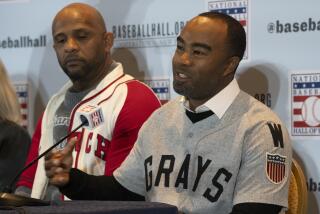Now He’d Say, ‘Let’s Play <i> One</i> ‘
- Share via
CHICAGO — Remember in the “good ole days” when you could look forward to going to a doubleheader at your favorite ballpark?
For those who couldn’t afford or couldn’t make time to go to the park regularly, the doubleheader was a fan’s dream: two games in one day. Two games for one price.
Why, Chicago Cubs’ Hall of Famer Ernie Banks probably earned more fame for saying “let’s play two today” than he did slugging more than 500 home runs.
But doubleheaders--the scheduled ones, at least--are becoming a vanishing item in baseball today. And with the unbelievably dry weather during April and early May, there have been no rainouts to create those July and August twin-bills.
Teams used to try to schedule about a half dozen or so doubleheaders, usually on Sundays. But in the National League, you are going to have to wait until Friday, June 7, in Riverfront Stadium in Cincinnati to see your first regularly-scheduled twin-bill.
And that won’t be a day doubleheader; it’s a twi-nighter.
Some teams aren’t scheduling any doubleheaders this year. Montreal, Chicago, Atlanta, Pittsburgh, St. Louis, Houston and Los Angeles plan to play the maximum amount of dates--81. The Mets, Phillies, and Reds promise just one twin-bill. The defending NL champion San Diego Padres and San Francisco Giants list two doubleheaders.
Things are not much different in the American League.
Seattle, California, Texas, Kansas City, Minnesota, Chicago, Milwaukee, Baltimore, the New York Yankees and Boston don’t have any doubleheaders scheduled. Only Oakland, Detroit, Cleveland and Toronto promise one on the schedule.
There are, of course, reasons for the disappearance of scheduled doubleheaders. The growth of the Players’ Association through the years has helped curb the doubleheaders, which most players don’t care for.
The players’ argument can be based on the lengthening of single games. Last year, the average time of American League games was two hours, 37 minutes and in the National League it was two hours, 35 minutes. That’s quite a jump from the two hour, 10 minute average of 25 years ago when doubleheaders were more common.
Managers, like the White Sox’ Tony LaRussa, also have another point.
“You’ll find that by and large, more of the doubleheaders are split,” LaRussa argues, “and that also means you are using your pitching staff and in some cases, going right through a pitching staff, in one day.”
It may be true about the pitchers, but in the National League last year 22 doubleheaders were swept by one team (the Cubs won five, tops in the league) while only 15 were split.
Expansion has also diluted the number of doubleheaders. When there were only eight teams in each league, doubleheaders could be scheduled comfortably because of the shorter distances that needed to be traveled. It is hard for some people to remember that major league baseball once was never farther west than St. Louis.
“There are economic reasons, too,” says Sox President Eddie Einhorn. “The more dates you have the more revenue that can come in from parking, concessions and the like.”
Additionally, by scheduling single games, you have less flirtation with the weatherman who can be very unfriendly to major league schedules.
“You can run the risk of raining out a scheduled doubleheader,” Einhorn adds. “Then you are talking about not just making up one game but two.”
That never seemed to deter the teams in the old days. But Einhorn’s point is a little more germaine in the American League, where each club makes only two trips into each city each year.
In the National League, clubs make three intradivision trips each year and two to the other division. As a result, the only reasonable time to schedule doubleheaders would be for National League teams that play division rivals.
The money factor is a primary reason clubs went away from doubleheaders. Why schedule a doubleheader when the usually attractive Los Angeles Dodgers or New York Yankees come into your stadium and you can have two dates and possibly double your attendance?
Doubleheader freaks could argue with some degree of truth that in some cases, Sunday doubleheaders would fill a stadium more than single dates would.
That is an argument made more from fans of teams like Chicago, St. Louis or Cincinnati, that rely heavily on weekend group tours for some of their gate.
Fans motoring in from Memphis, Peoria or Lexington, Ky., would more likely schedule a weekend trip when they knew there was a doubleheader on Sunday instead of single games. When that may be your only trip into the major league city in a given summer, you want to get your money’s worth.
So, if you are planning to see a doubleheader in 1985--or in the coming years--go through your pocket schedules carefully.
Or pray for some heavy rains.
More to Read
Go beyond the scoreboard
Get the latest on L.A.'s teams in the daily Sports Report newsletter.
You may occasionally receive promotional content from the Los Angeles Times.










